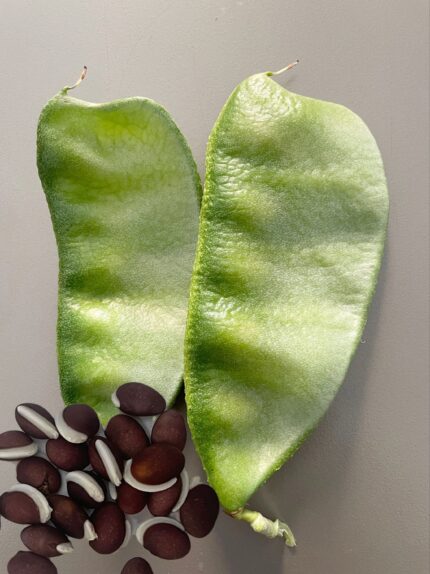The term “cluster broad bean” doesn’t refer to a specific, widely recognized variety of broad bean but might describe a growing habit or characteristic of certain cultivars of *Vicia faba* (broad beans), where the beans grow in clustered pods rather than singly or in a more scattered pattern. Here’s a breakdown of the general aspects of broad beans and how they might grow in clusters:
General Characteristics of Cluster Broad Beans:
1. Plant Growth Habit:
– Broad beans typically grow in a tall, upright form, reaching heights of 2 to 4 feet (60 to 120 cm), depending on the variety and growing conditions. The plant produces large, green leaves and white or purple flowers, which eventually develop into pods.
2. Pod Clustering:
– In some varieties or under specific growing conditions, broad bean pods may appear to grow in clusters. This could refer to multiple pods emerging closely together along the stem or at branch tips, giving the impression of a “cluster” of pods.
– Pods usually contain 3 to 7 seeds (beans), and while they are generally spaced apart on the plant, certain cultivars may have a tendency to produce pods in denser groupings.
3. Seed Variety and Appearance:
– The beans (seeds) themselves are large, flat, and typically green when young, turning brown or black as they mature. Some varieties might be bred for specific characteristics, such as compact growth or early pod-setting, which could result in the beans being harvested from clustered pods.
Planting and Growing Cluster Broad Beans:
– Soil: Broad beans thrive in fertile, well-drained soil, preferring slightly alkaline conditions (pH 6.0 to 7.5).
– Climate: These beans are cool-season crops, typically grown in spring or autumn in temperate climates. They do not tolerate frost well, but they can withstand a light frost once they are established.
– Spacing: Broad beans are usually planted 6 to 8 inches apart in rows that are 12 to 18 inches apart. However, if they tend to grow in clusters, you may notice that the pods develop in tighter groups, which can influence how you space them in your garden.
Uses and Benefits:
– Edible Seeds: Both the young beans (when still green) and the mature beans (when dried) are edible. They are used in a variety of dishes, such as soups, stews, and salads, or mashed as a spread.
– Nutritional Value: Broad beans are an excellent source of plant-based protein, dietary fiber, vitamins (such as folate and B-vitamins), and minerals like iron and magnesium.
– Soil Health: Like other legumes, broad beans are nitrogen-fixing plants, improving soil fertility by converting atmospheric nitrogen into a form that is usable by plants.
Potential Varieties and Cultivars:
– Some varieties of broad beans might have a more compact growth habit, resulting in more clustered pods, such as ‘Aquadulce Claudia’,The Sutton, or Windsor.
– Dwarf or compact varieties** are particularly useful for smaller gardens or for those who want a more densely packed harvest.
Harvesting Cluster Broad Beans:
– Broad beans are typically harvested when the pods are fully formed but still tender. You can pick them while the beans are young and green, or wait until they are mature, at which point they can be dried for storage.









Reviews
Clear filtersThere are no reviews yet.